AI tools are advancing rapidly, offering solutions for almost every productivity challenge. Whether it’s enhancing the apps you already use or introducing entirely new platforms, multi-agent systems are transforming the way businesses operate.
I’ve spent time exploring these tools, researching their capabilities, and testing them to see how they improve workflows. Based on this, I’ve put together a list of the nine best multi-agent platforms that can help you automate tasks, boost collaboration, and streamline operations.
What are Multi-Agent Platforms?

Multi-agent platforms are AI tools that use multiple agents to work together. These agents can communicate, share data, and collaborate to complete tasks. They can help automate complex workflows, improve productivity, and streamline communication in your business.
Benefits of Using Multi-Agent Platforms
Multi-agent platforms offer several advantages:
- Increased productivity: Automate repetitive tasks so your team can focus on strategic work.
- Improved collaboration: AI agents can share data and insights, enhancing teamwork and decision-making.
- Reduced errors: Automate routine tasks to minimize human mistakes.
- Better customer service: AI agents can assist with customer interactions, providing quick responses and escalating issues to human reps when needed.
- Cost savings: Automating processes can reduce labor costs and improve efficiency.
How I Chose the Best Multi-Agent Platforms
There are countless AI tools available today, with new ones launching all the time. While I haven’t tested every single one, I’ve researched and evaluated many of them to find the best multi-agent platforms for businesses. This list is based on hands-on testing and careful analysis of each platform’s features, usability, and impact on productivity.
AI is constantly evolving, and while these tools can greatly improve workflows, they aren’t perfect. It’s always a good idea to review AI-generated work and ensure it aligns with your needs. With that in mind, let’s dive into the best multi-agent platforms available today.
The Best Multi-Agent Platforms
Here are the 9 best multi-agent platforms you should consider for your business:
1. AutoGen
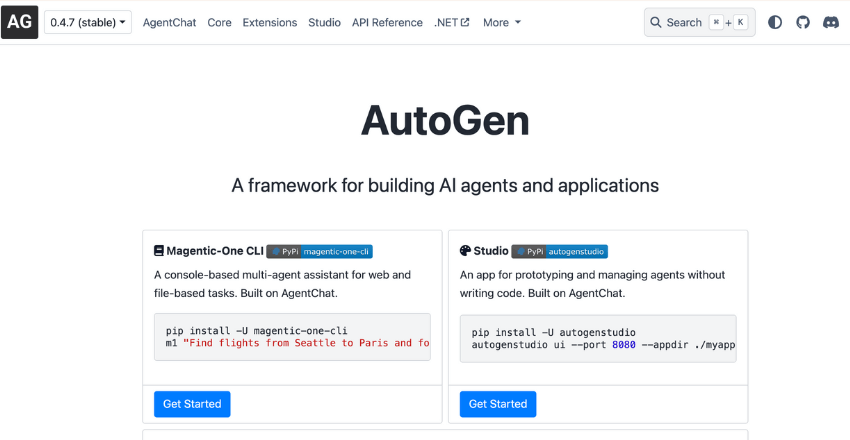
AutoGen is a platform for building and deploying multi-agent systems. It offers tools for automating complex workflows and integrating multiple AI agents.
Best for: Workflow automation
Key features: No-code interface, flexible AI agent creation, task management
How Each Feature Benefits You
- No-code interface: You can build and manage AI agents without needing programming skills, making it easy to automate tasks without hiring a developer.
- Flexible AI agent creation: Customize AI agents to fit your business needs, whether it’s automating repetitive tasks or handling complex workflows.
- Task management: Organize, assign, and track tasks efficiently, ensuring your AI agents complete work accurately and on time.
Pros: Easy to use, supports various AI models
Cons: Limited advanced features in the free version
Pricing: Free plan available; paid plans start at $20/month
What
2. CrewAI

CrewAI is an open-source platform for creating multi-agent automations. It allows you to build AI agents using any large language model (LLM).
Best for: Custom AI automations
Key features: No-code and low-code options, template library
How Each Feature Benefits You
No-code and low-code options: Whether you have no technical background or some coding experience, you can easily build and customize AI agents to fit your business needs without extensive programming knowledge. This makes automation accessible to a wider range of users.
Template library: Get started quickly with pre-built templates for common workflows. Instead of building everything from scratch, you can customize existing setups to save time and streamline your processes.
Pros: Highly customizable, track agent performance
Cons: Requires some technical knowledge
Pricing: Contact for pricing
3. LangChain
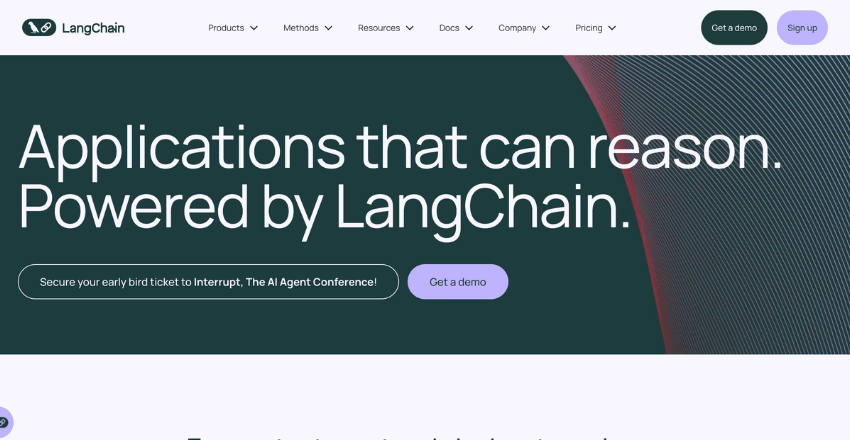
LangChain provides tools for building AI-powered applications using LLMs. It enables the creation of complex multi-agent systems.
Best for: Developing AI applications
Key features: LLM integration, agent orchestration, data connectors
How Each Feature Benefits You
LLM integration: You can connect LangChain to powerful large language models (LLMs) like GPT-4, enabling AI agents to process natural language, generate responses, and perform complex reasoning tasks. This improves automation, decision-making, and content creation.
Agent orchestration: Easily manage and coordinate multiple AI agents working together on different tasks. This allows you to build workflows where AI agents communicate, share data, and complete multi-step processes efficiently.
Data connectors: Integrate AI agents with various data sources, such as databases, APIs, or cloud storage. This ensures that your agents always have access to the latest information, leading to more accurate and context-aware responses.
Pros: Strong developer community, flexible architecture
Cons: Steep learning curve for beginners
Pricing: Free; paid plans available
4. MetaGPT
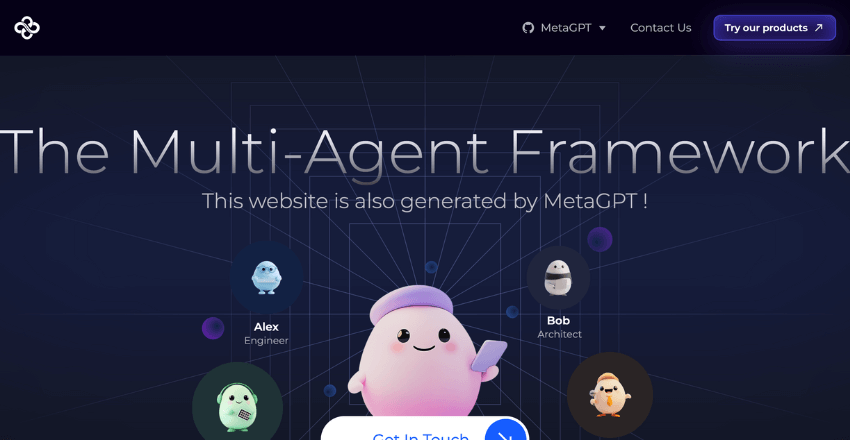
MetaGPT is a platform for building multi-agent systems that handle various tasks in content creation and project management.
Best for: Content automation
Key features: Task automation, prompt engineering, AI collaboration
How Each Feature Benefits You
Task automation: Save time by letting AI handle repetitive or complex tasks, such as content creation, data processing, and workflow management. This allows you to focus on strategic work instead of manual processes.
Prompt engineering: Fine-tune AI responses by customizing prompts for specific tasks. This ensures more accurate, relevant, and high-quality output, whether you’re generating text, analyzing data, or assisting customers.
AI collaboration: Enable multiple AI agents to work together, improving efficiency and problem-solving. This helps streamline teamwork by allowing AI to assist with brainstorming, project management, or customer support.
Pros: Streamlines content creation, supports multiple agents
Cons: Limited integrations
Pricing: Free trial; paid plans start at $15/month
5. Cogniflow
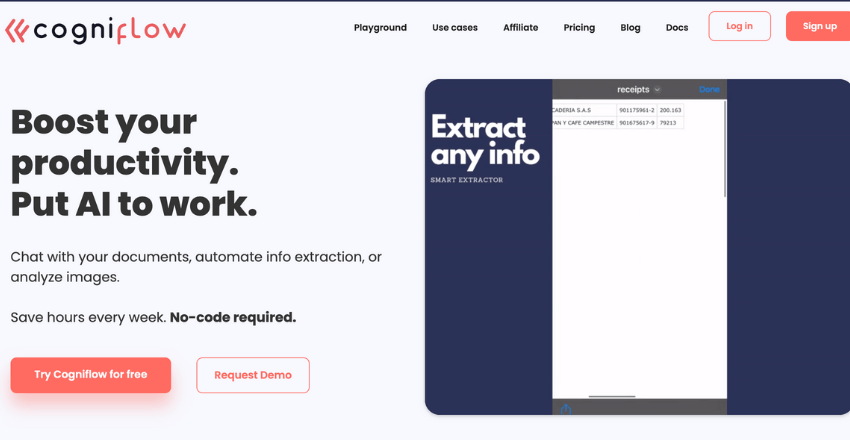
Cogniflow allows users to build AI models and multi-agent systems without coding. It focuses on automating business processes.
Best for: No-code AI development
Key features: Visual AI builder, data analysis, workflow automation
How Each Feature Benefits You
Visual AI builder: Easily create and customize AI models using a drag-and-drop interface. You don’t need coding skills, making it simple to design AI solutions tailored to your business needs.
Data analysis: Gain insights by allowing AI to process and interpret large amounts of data. This helps you make informed decisions faster, identify trends, and optimize business strategies.
Workflow automation: Automate repetitive tasks, such as document processing, customer inquiries, or data entry. This reduces manual work, minimizes errors, and improves overall efficiency.
Pros: Easy-to-use interface, fast deployment
Cons: Advanced features require a paid plan
Pricing: Free version; paid plans start at $25/month
6. Vertex AI Agent Builder
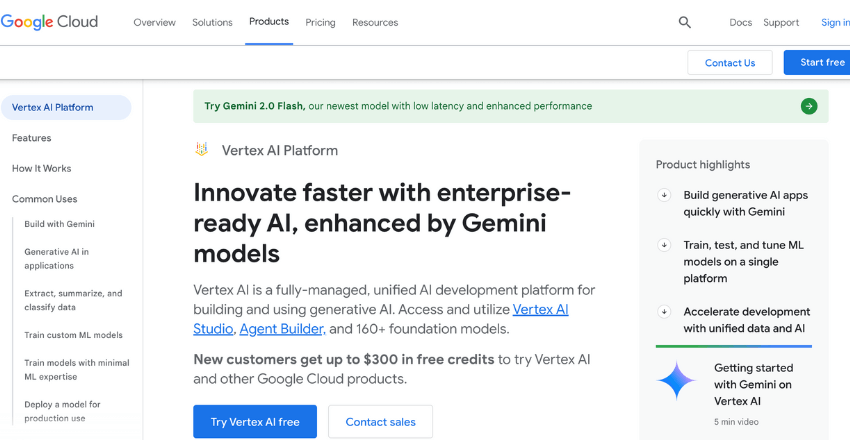
Vertex AI Agent Builder by Google helps businesses create AI agents for various applications. It supports advanced machine learning models.
Best for: Enterprise-level AI development
Key features: Scalable AI agents, integration with Google Cloud
How Each Feature Benefits You
Scalable AI agents: Easily build AI agents that grow with your business. Whether you’re handling a small set of tasks or need enterprise-level automation, Vertex AI adapts to your needs without requiring a complete system overhaul.
Integration with Google Cloud: Seamlessly connect AI agents with Google’s ecosystem, including BigQuery, Google Drive, and other cloud-based tools. This ensures smooth data flow, enhances collaboration, and improves AI performance with access to Google’s powerful computing resources.
Pros: Robust features, secure infrastructure
Cons: Complex setup process
Pricing: Contact for pricing
7. ChatDev

ChatDev is a platform for building multi-agent chatbots that can handle customer service and internal communication tasks.
Best for: Customer service automation
Key features: Multi-agent chat system, real-time communication
How Each Feature Benefits You
Multi-agent chat system: Improve efficiency by allowing multiple AI agents to work together in a conversation. This enables better automation for customer support, internal collaboration, and task execution, reducing the need for human intervention.
Real-time communication: Get instant responses and seamless interactions between AI agents and users. This speeds up decision-making, enhances customer service, and keeps workflows running smoothly without delays.
Pros: Enhances customer experience, reduces response time
Cons: Limited customization options in the free plan
Pricing: Free trial; paid plans start at $10/month
8. LangGraph
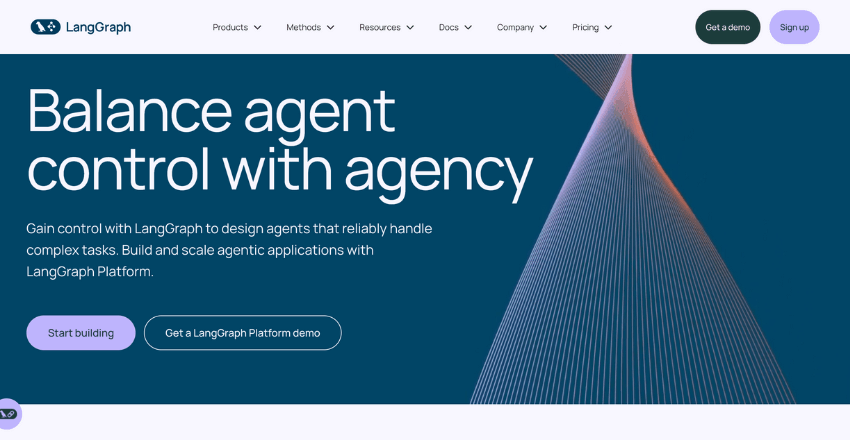
LangGraph is a tool for creating multi-agent workflows using LLMs. It helps automate data processing and content generation.
Best for: Data-driven workflows
Key features: Graph-based workflow builder, LLM integration
How Each Feature Benefits You
Graph-based workflow builder: Visually design and manage complex AI-driven workflows. This allows you to map out how AI agents interact, making it easier to create, track, and optimize automation processes without needing deep technical expertise.
LLM integration: Connect with large language models (LLMs) like GPT-4 to enhance AI agents’ ability to understand, generate, and process information. This leads to smarter decision-making, improved content generation, and more effective automation.
Pros: Visual workflow design, easy data management
Cons: Requires technical knowledge for advanced features
Pricing: Free version; paid plans available
9. Appy Pie
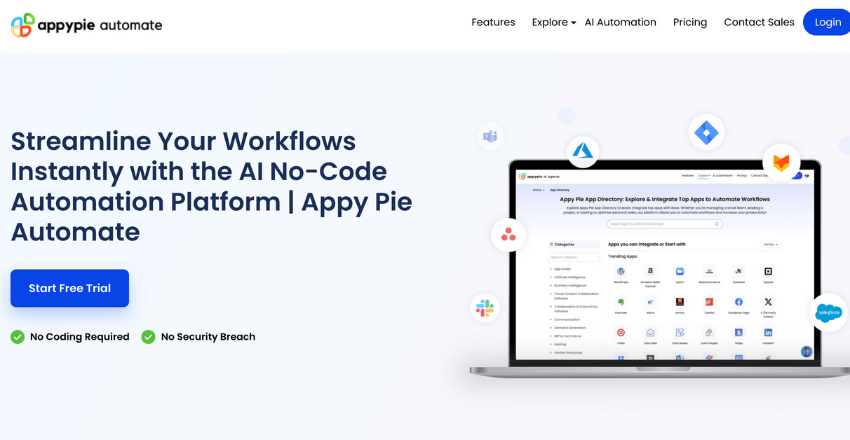
Appy Pie is a no-code platform for building AI-powered multi-agent systems that automate workflows and improve business efficiency.
Best for: No-code AI automation
Key features: No-code development, workflow automation, multi-platform integration
How Each Feature Benefits You
No-code development: Build AI agents and automate workflows without any coding knowledge. This makes it easy for anyone—regardless of technical skills to create powerful automation tools for their business.
Workflow automation: Streamline repetitive processes by allowing AI agents to handle tasks like scheduling, customer interactions, and data management. This reduces manual work and increases productivity.
Multi-platform integration: Connect with various apps and tools to ensure smooth data flow across your business. This improves collaboration and keeps your systems running efficiently.
Pros: Easy to use, supports multiple app integrations, accessible for non-developers
Cons: Limited advanced customization options, free plan has restrictions
Pricing: Free trial available; paid plans start at $12/month
Challenges and Considerations
Before choosing a multi-agent platform, consider these factors:
- Privacy and security: Ensure the platform handles your data securely.
- Learning curve: Some platforms require technical knowledge.
- Compatibility: Check if the platform integrates with your existing tools.
- Cost: Compare pricing plans to fit your budget.
Multi-Agent Platforms
Multi-agent platforms are getting better fast. AI tools keep improving, adding new features that make work easier and more efficient. Businesses now have plenty of options to automate tasks, improve teamwork, and simplify processes. As AI continues to evolve, these platforms will become even more important for helping businesses run smoothly and succeed.
Allow us to introduce you to Edward, a distinguished figure in the realm of autonomous AI, serving as the Chief Data Scientist of a prominent organization. Edward’s journey into the fascinating world of data science was forged through the crucible of rigorous education at the prestigious Caltech. With a deep-rooted passion for unlocking the secrets of data, he has seamlessly blended his academic prowess with real-world innovation, shaping the future of autonomous AI.
Beyond the world of algorithms and data sets, Edward finds balance in his life in the bustling city of Los Angeles, where he resides with his loving wife and three cherished daughters. Despite the demands of his groundbreaking work, he cherishes the simple joys of family and frequently embarks on leisurely walks, not only as a form of relaxation but also as a source of inspiration. Join us on a journey through Edward’s world, where the intricate dance of data science and the warmth of family life intertwine, offering a unique perspective on the evolving landscape of autonomous AI.





